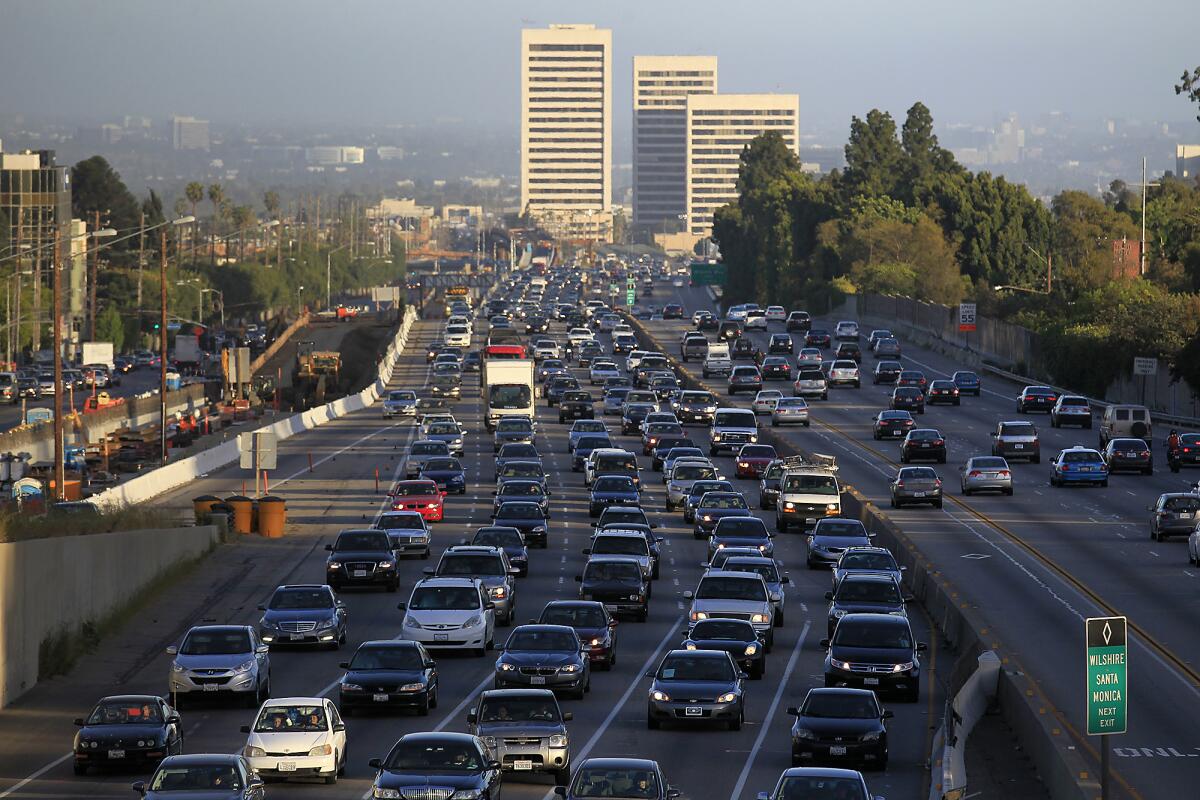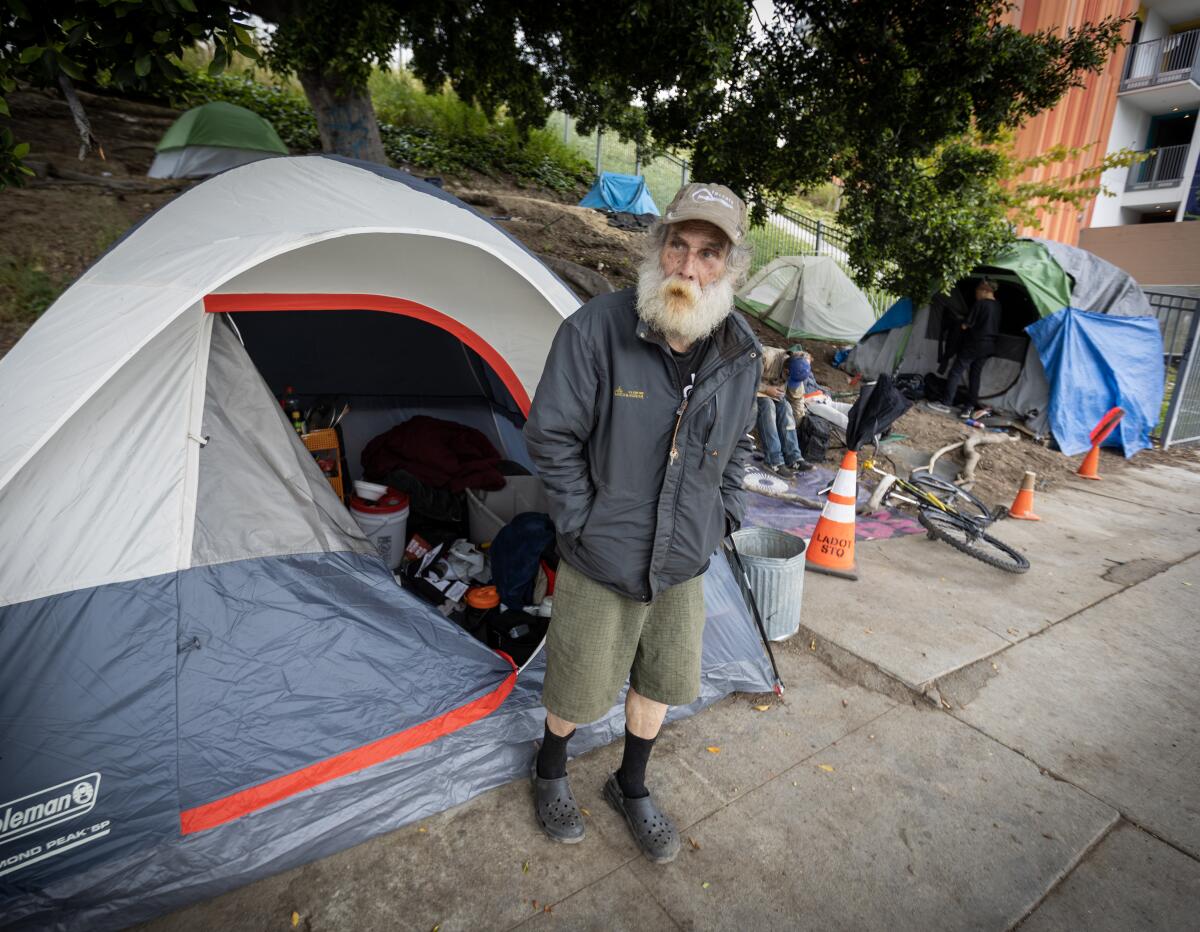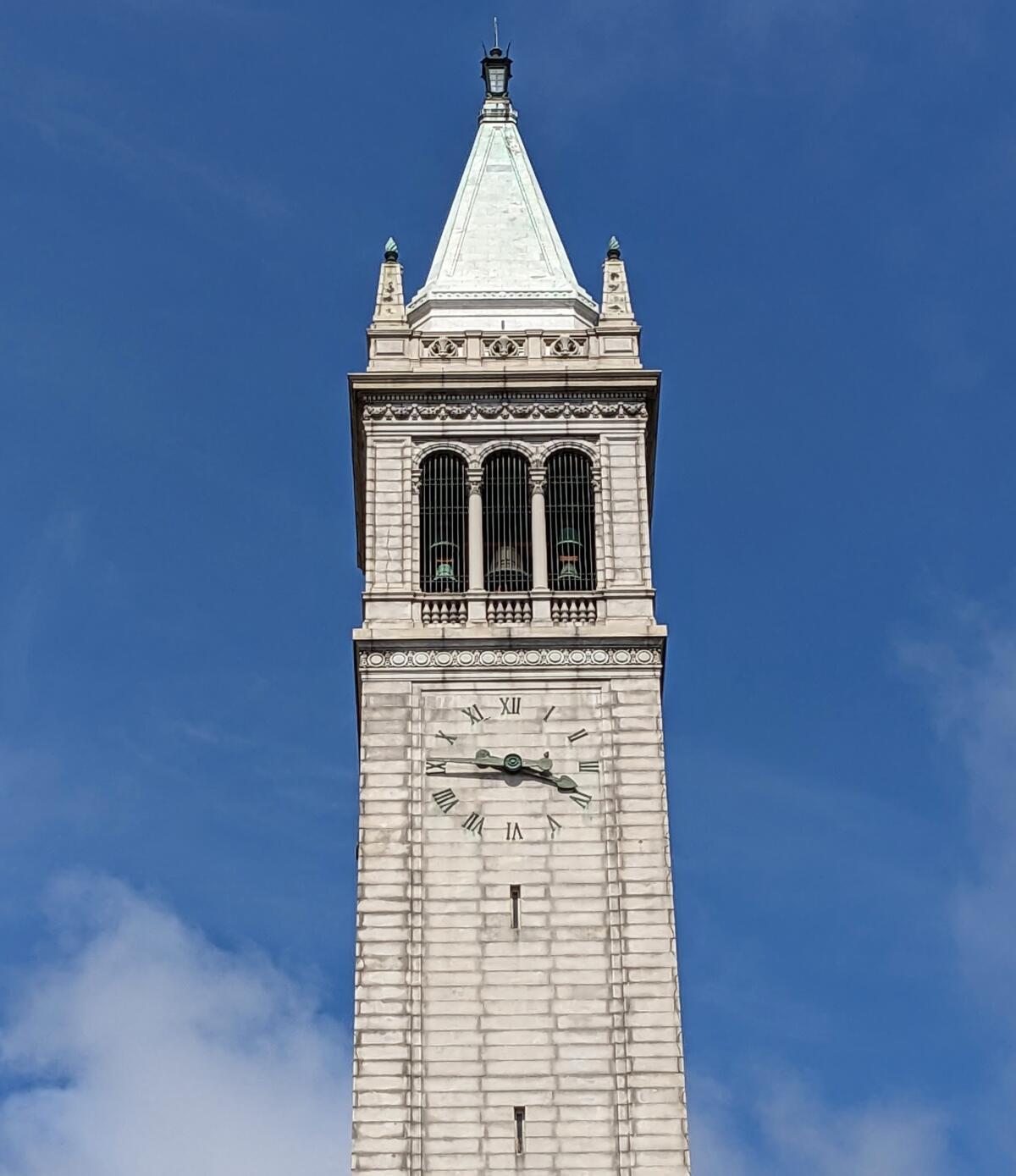L.A. could try congestion pricing. Will drivers go for it?

Good morning, and welcome to the Essential California newsletter. It’s Wednesday, May 31.
There’s a deep-seated idea that driving = freedom. Look no further than car commercials, many of which market motor vehicles as freedom machines. It’s just you (actually, Matthew McConaughey — but it could be you!), your foot on the gas, hands on the wheel and a conveniently empty road, beckoning you to drive off into the sunset.
Of course, to get that perfect shot of a shiny new model zipping through downtown streets, the route had to be closed off to anyone else trying to drive. You won’t see Janelle Monáe or Brie Larson stuck in traffic because that reality doesn’t mesh well with the fantasy that carmakers aim to associate with their product.
In L.A., the average driver spent an estimated 95 hours last year — just shy of four days — stuck in traffic, according to the transportation analytics firm Inrix.
In a society where driving is so firmly linked to liberty, should using our cars whenever and wherever we want be free? Transportation officials in L.A. and beyond have been mulling that question, guided by an inconvenient truth about traffic congestion: The only way to truly fix it is for people to drive less (easier said than done).
One strategy that’s been successful in some cities on the other side of the world: charging people to drive in certain zones and/or at certain times — a concept known as congestion pricing.
In the car-rich Los Angeles County, transportation officials are expected to publicly share long-awaited plans to experiment with congestion pricing on our infamously clogged freeways and arterial roads.
“Years in the works, the plan promises cleaner air, smoother rides and more funds to the agency’s coffers in the future,” Times transportation reporter Rachel Uranga wrote this week. “Studies show it could reduce harmful air pollution and greenhouse gas emissions by pushing more commuters to use public transit, while making roads less hellish for those who pay to use them.”
L.A. Metro is eyeing the possible charge in a few high-traffic zones:
- Along the 10 Freeway between downtown and Santa Monica
- On arterial streets and freeways around downtown Los Angeles
- Through the canyon streets and freeways that link the San Fernando Valley to West L.A. and the rest of the basin
Details on how drivers would be charged, how much and how often, as well as how much money Metro expects to collect haven’t been finalized. But some early modeling the agency “quietly shared with interest groups” included a figure of up to $2.5 million daily in gross revenue, Rachel reported.
It’s not just L.A.; similar models are being considered in the San Francisco Bay Area, by state transportation officials and at the federal level. “But perhaps nowhere in the United States would it be as consequential as in car-centric Los Angeles,” Rachel wrote, “the land of the SigAlert and the birthplace of the freeway, where commute times, traffic collisions and gas prices play large in the daily consciousness.”
The suggestion that drivers should pay to access roads is sure to infuriate some and bound to fuel some misconceptions about what the plan would actually mean. Metro aims to try out a congestion charge during peak hours, when the demand for driving is highest.
“It’s not that someone flips a switch and suddenly, you just can’t drive,” Michael Manville, an associate professor of urban planning at the UCLA Luskin School of Public Affairs, told Rachel. “It’s that you’re going to be a little bit more judicious about when you choose to drive when the time is expensive.”
Congestion pricing has been in place for decades in Singapore, with notable results. The cities of Stockholm and London implemented their own policies in the 2000s and saw congestion fall.
But despite those successes, congestion pricing hasn’t been an easy sell elsewhere, as Stuart Cohen, founder and senior advisor of the Bay Area advocacy group TransForm, told Rachel:
“Even there, those [programs] have been implemented for a couple of decades and it hasn’t really spread throughout Europe, which I think just gives you a sense of the politics really aren’t easy anywhere.”
Of course the idea of charging people to drive on roads they’ve long been able to access for free is politically fraught, to put it mildly.
So much so that Metro Chief Executive Stephanie Wiggins delayed the release of her agency’s congestion pricing study during the 2022 election cycle. As Rachel reported:
“She didn’t want the plans out during the election season, when the issue would have become a political hot potato as seats were up for grabs on the City Council and the Board of Supervisors and for mayor, according to those close to the project at the time, who asked not to be named.”
While L.A. drivers (other than those who use ExpressLanes) aren’t currently charged to drive on freeways and other high-demand roads, there are costs that come from our driving: the time we spend crawling on clogged routes — and the resulting impact that has on air quality, our health, the environment — and the general livability of our communities. But the idea of transmuting some of those costs into a fee levied by government will prove a hard sell.
We can’t build our way out of traffic
Maybe you’re thinking there’s a more obvious solution: Just build more roads! Widen the freeways!
History shows us that won’t work. Remember the five-year, $1-billion project to add more lanes to the 405 Freeway through the Sepulveda Pass? Transportation officials said it was meant to reduce congestion, but it actually made rush-hour traffic even worse in the corridor, a study later found.
That’s because of another inconvenient truth about driving: a concept experts call induced demand. When we add more space for people to drive their cars, more people drive in that space, and congestion gets worse.
Widening freeways in many places would also mean demolishing homes, businesses and community spaces in neighborhoods that have long been suffering the negative effects of freeways, including hazardous air, the resulting health risks and noise pollution.
That kind of government-led action could further perpetuate the inequities borne by Black and brown residents, who are disproportionately affected by freeways.
A charge by itself likely isn’t enough
While Metro has yet to publish its study, officials have said the pilot program aims to address equity concerns with subsidies for low-income drivers and carpoolers, plus funding that would create alternatives to car travel.
That’s one vital piece in the potential success of a congestion pricing plan: improving public transit and infrastructure for other mobility modes (like biking or walking) to make those options more competitive with driving. If commuters have better choices in getting from A to B — especially during peak hours — fewer people will drive, the logic goes, making traffic less of a nightmare for the people who do choose to drive at a premium.
Now we want to hear from you, readers. How do you feel about congestion pricing? Would you be willing to pay to drive at high-demand times if it saves you time getting where you’re going?
Fill out this survey to let us know. You might see your and fellow readers’ responses in an upcoming edition of Essential California.
And now, here’s what’s happening across California:
Note: Some of the sites we link to may limit the number of stories you can access without subscribing.
L.A. STORIES
A little over 55 years ago, the Rev. Martin Luther King Jr. and James Baldwin visited Beverly Hills and boldly spoke out against the Vietnam War. “King and Baldwin must have been keenly aware of how their impromptu ensemble destabilized their reputations,” Harmony Holiday wrote for the Times’ Image. “They had roles, and they were in L.A. ruining them.” Los Angeles Times
Fighting corruption in 1920s and 1930s Los Angeles was a rough gig. Columnist Patt Morrison chronicles the crusades of Angelenos who squared off against dirty LAPD leaders, who orchestrated bombings in bids to stop them. Los Angeles Times
POLITICS AND GOVERNMENT
To address the state’s housing crisis, one lawmaker wants to build “social housing” that’s affordable for all Californians. A new bill from State Assemblymember Alex Lee (D-San Jose) would create a state agency to develop housing, which he argues will reduce costs by removing motives for profit. The Mercury News
L.A. Mayor Karen Bass’ Inside Safe initiative aims to get unhoused people off city streets and into nearby hotel rooms. But her plan is facing resistance downtown, with Bass’ homelessness czar saying “the array of needs did not allow us to get everyone into housing.” Los Angeles Times

There’s a new effort in La Jolla to break off from San Diego and form an independent city. Proponents of a secession cite decaying infrastructure and other amenities they claim San Diego has neglected to fix, along with the city’s plans to add more housing. San Diego Union-Tribune
CRIME, COURTS AND POLICING
A high-profile show-and-tell played out in a California courtroom last week. An L.A. County sheriff’s deputy showed a tattoo revealing his affiliation with the suspected deputy gang known as the Executioners. He also named names during the civil trial, which stems from retaliation claims by a sheriff’s lieutenant who said he was demoted for reporting gang activity by deputies at the Compton station. Los Angeles Times
Leslie Van Houten, a follower of Charles Manson who was convicted in the murders of Leno and Rosemary LaBianca, could soon be freed on parole. A state appeals court overruled Gov. Gavin Newsom’s denial of her release from prison. Los Angeles Times
Support our journalism
HEALTH AND THE ENVIRONMENT
An environmental group has asked the state to stop diverting water from Mono Lake to Los Angeles. But local water managers are pushing back, arguing the water from the lake on the eastern edge of the Sierra Nevada is a vital part of the city’s supply. CalMatters
Plans to restore the Ballona Wetlands have been paused. A judge ruled that the California Department of Fish and Wildlife’s environmental impact report did not properly account for flood risks. The controversial project has faced a string of lawsuits. Los Angeles Times
Free online games
Get our free daily crossword puzzle, sudoku, word search and arcade games in our new game center at latimes.com/games.
AND FINALLY
Today’s California landmark comes from David Hayashida of Greenbrae: the “iconic” Campanile bell and clock tower at UC Berkeley, also known as Sather Tower.

David writes:
[It’s the] current home of the adult peregrine “Cal Falcons,” Annie and Lou, and their three fledglings, Rosa, Zephyr and Luna. If you look closely, that’s Lou perched on the base of the minute hand, telling us it’s almost time for dinner!
What are California’s essential landmarks? Fill out this form to send us your photos of a special spot in California — natural or human-made. Tell us why it’s interesting and what makes it a symbol of life in the Golden State. Please be sure to include only photos taken directly by you. Your submission could be featured in a future edition of the newsletter.
Please let us know what we can do to make this newsletter more useful to you. Send comments to [email protected].
Sign up for Essential California
The most important California stories and recommendations in your inbox every morning.
You may occasionally receive promotional content from the Los Angeles Times.




